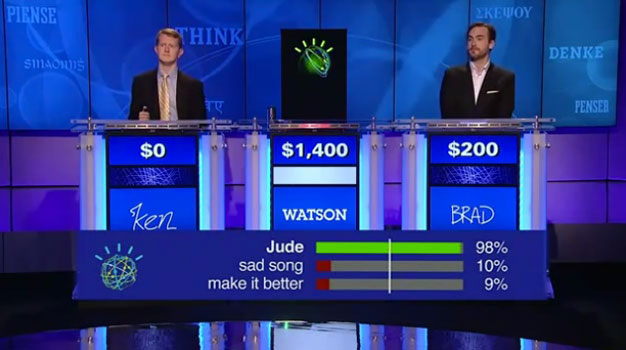An IBM supercomputer named Watson is tied for first place after the airing last night of the first of three exhibition episodes of the popular quiz show game Jeopardy!. Facing Jeopardy!’s two most successful contestants, Watson was tied for first place with $5,000 dollars at the end of the first episode. Ken Jennings, famous for his 2004, 75-game Jeopardy! run, was trailing in third with $2,000.
Watson took the lead early in the game, in which contestants are presented with six categories of questions from which to choose. After answering the second clue correctly, the supercomputer selected a randomly-placed Daily-Double, which allows players to wager as much as they have on a question. Watson bet the maximum, and answered correctly, bringing him to $1,400. His two opponents were still stuck at $0 and $200.
The supercomputer did cool off a bit after his strong opening. Occasionally, his answers came close to correct answers but he could not figure out what exactly the question was asking. To a question whose correct answer was “missing a leg,” Watson merely answered “leg.” For another question, Watson repeated another contestant’s incorrect answer. But these were hiccups in an otherwise dominating performance.
Watson’s two human competitors were Ken Jennings and Brad Rutter. Rutter first appeared on Jeopardy! in 2000 and went on to win five-times in a row, the then limit on repeat appearances. Rutter also won a number of special Jeopardy! tournaments taking home a total of $3.2 million. Ken Jennings appeared onJeopardy! in 2004, a few months after the five-time-appearance limit was removed. Jennings went on to win 74 games in a row, raking in $2.4 million dollars.
Personified with a disembodied male voice and a glowing spherical avatar, Jeopardy! host Alex Trebek explained in a show segment that the supercomputer actually sits in a room next to the studio where the episodes were filmed. “When you link all these servers together, as they have done for Watson, you create a deep analytic system that is the equivalent of 2,800 computers tied together in a super-high speed network,” Trebek explained. It has 15 terabytes of memory but is not connected to the internet.
Viewers saw a glimpse of Watson’s thinking on-screen during the match. As he “heard” each question, Watson’s top three choices were displayed below him along with how sure he was that they were correct. Once an answer met a certain threshold, the Watson physically buzzed in using a buzzer identical to that of its human competition.
The three answer choices gave insight into how Watson processed questions. In a question from a Beatles-themed category, the correct answer was John Lennon’s mother, Julia. Watson’s top three picks in order were Julia, Yoko Ono and Lucinda Williams. Ono was married to Lennon, and Williams is an unrelated country and rock singer. Another question asked for a word that had definitions that denoted both a thief and the bent part of an arm. The answer was “crook,” but Watson was not sure, guessing first knee, then waist, and finally crook.
Trebek opened the first episode explaining the importance of exhibition match, “A little over three years ago, folks at IBM came to us with a proposal that they considered to be the next grand challenge in computing. And that was designing a computer system that could understand the complexities of natural language well enough to compete against Jeopardy!’s best players.”
In an interview with IBM’s David Gondek, Engadget’s Paul Miller asked how Watson thinks. Gondek explained how Watson has many algorithms each trying to answer the question simultaneously. “All of [Watson’s] analytics are firing. If they think they know something about the answer, they’ll produce a score for that answer. At the end we weigh all the those algorithms together and come up with a combined confidence that you” see on the screen, Gondek explained.
Gondek also added that Watson’s algorithms dynamically update based on new correct and incorrect answers — in other words, it learns from its mistakes.
These Jeopardy! matches are not the first time that humans have gone head-to-head with IBM supercomputers. In 1996, world champion chess player Gary Kasparov famously sat opposite IBM’s Deep Blue computer in a six-game match that Kasparov definitely won. But an improved Deep Blue came back a year later and trounced Kasparov. Kasparov accused IBM of cheating and demanded a rematch.
Tonight’s show will feature the concluding half of the first Jeopardy!game. Wednesday’s show will feature the second exhibition match.






